The Jets of Microquasars during Giant Flares and Quiet State
Abstract
:1. Microquasars Studies with the RATAN-600 Telescope
2. Results
2.1. V404 Cyg
2.2. SS433
2.3. Cyg X-1
2.4. GRS1915+105
2.5. LS5039
2.6. LSI+61303
3. Discussion
Acknowledgments
Author Contributions
Conflicts of Interest
Abbreviations
| GRS | International Astrophysical Observatory ’GRANAT’ source |
| LSI | Luminous Stars in the Northern Milk Way 1 (1959) |
| MAXI | The Monitor of All-sky X-ray Image aboard the International Space Station |
| RATAN-600 | Radio Astronomical Telescope Academy of Science, Russia |
| SAO RAS | Special Astrophysical observatory, Russia |
| SS | Stephenson & Sanduleak calalog (1977) |
| Swift/BAT | Burst Alert Telescope aboard the Swift Cosmic Observatory |
| VLBA | Very Large Baseline Array of NRAO (USA) |
References
- Mirabel, I.F.; Rodriguez, L.F. Sources of Relativistic Jets in the Galaxy. Ann. Rev. Astron. Astrophys. 1999, 37, 409–443. [Google Scholar] [CrossRef]
- Trushkin, S.; Bursov, N.N.; Nizhelskij, N.A.; Majorova, E.K.; Voitsik, P.A. What do we understand from multi-frequency monitoring of microquasars? In Proceedings of the VI Microquasar Workshop: Microquasars and beyond, Como, Italy, 18–22 September 2006. [Google Scholar]
- Trushkin, S.A.; Nizhelskij, N.A.; Bursov, N.N. Multi-Frequency Radio Photometry of the Microquasars with the RATAN-600 Radio Telescope. In Twelfth Marcel Grossmann Meeting on General Relativity; Chamseddine, A.H., Ed.; World Scientific Publishing Co. Pte. Ltd.: Singapore, 2012. [Google Scholar]
- Trushkin, S.A.; McCollough, M.; Nizhelskij, N.A.; Tsybulev, P.G. The giant flares of the microquasar Cygnus X-3: X-rays states and jets. Galaxies 2018, in press. [Google Scholar]
- Miller-Jones, J.C.A.; Jonker, P.G.; Dhawan, V.; Brisken, W.; Rupen, M.P.; Nelemans, G.; Gallo, E. The First Accurate Parallax Distance to a Black Hole. Astrophys. J. Lett. 2009, 706, L230–L234. [Google Scholar] [CrossRef]
- Trushkin, S.A.; Nizhelskij, N.A.; Tsybulev, P.G. The Inverted Radio Spectrum of the Flare in V404 Cyg. The Astronomer’s Telegram, 16 June 2015. [Google Scholar]
- Trushkin, S.A.; Nizhelskij, N.A.; Tsybulev, P.G. A New Giant Radio Flare of V404 Cyg at Centimeter Wavelengths. The Astronomer’s Telegram, 26 June 2015. [Google Scholar]
- Barthelmy, S.D.; D’Ai, A.; D’Avanzo, P.; Krimm, H.A.; Lien, A.Y.; Marshall, F.E.; Maselli, A.; Siegel, M.H. Swift trigger 643949 is V404 Cyg. GRB Coordinates Network, Circular Service. 15 June 2015. 17929. Available online: http://adsabs.harvard.edu/abs/2015GCN..17929...1B (accessed on 21 November 2017).
- Piano, G.; Munar-Adrover, P.; Verrecchia, F.; Tavani, M.; Trushkin, S.A. High-energy Gamma-ray Activity from V404 Cygni Detected by AGILE during the 2015 June Outburst. Astrophys. J. 2017, 839, 84. [Google Scholar] [CrossRef]
- Chandra, P.; Kaneka, N. Giant Metrewave Radio Telescope Monitoring of the Black Hole X-ray Binary, V404 Cygni during Its 2015 June Outburst. Astrophys. J. 2017, 846, 111. [Google Scholar] [CrossRef]
- Jeffrey, R.M.; Blundell, K.M.; Trushkin, S.A.; Mioduszewski, A.J. Fast launch speeds in radio flares, from a new determination of the intrinsic motions of SS 433’s jet bolides. Mon. Not. Roy. Astron. Soc. 2017, 461, 312–320. [Google Scholar] [CrossRef]
- Reid, M.J.; McClintock, J.E.; Steiner, J.F.; Steeghs, D.; Remillard, R.A.; Dhawan, V.; Narayan, R. A Parallax Distance to the Microquasar GRS 1915+105 and a Revised Estimate of its Black Hole Mass. Astrophys. J. 2014, 796. [Google Scholar] [CrossRef]
- Punsly, B.; Rodriguez, J.; Trushkin, S.A. The Accretion Flow-Discrete Ejection Connection in GRS 1915+105. Astrophys. J. 2016, 826, 5. [Google Scholar] [CrossRef]
- Casares, J.; Ribo, M.; Ribas, I.; Paredes, J.M.; Marti, J.; Herrero, A. A possible, black hole in the γ-ray microquasar LS 5039. Mon. Not. Roy. Astron. Soc. 2005, 364, 899–908. [Google Scholar] [CrossRef]
- Marti, J.; Paredes, J.M.; Ribo, M. The system LS 5039: A new massive radio emitting X-ray binary. Astron. Astrophys. 1998, 338, L71–L74. [Google Scholar]
- Ribo, M.; Reig, P.; Marti, J. X-ray and radio observations of RX J1826.2-1450/LS 5039. Astron. Astrophys. 1999, 347, 518–523. [Google Scholar]
- Massi, M. LSI+61°303 in the context of microquasars. Astron. Astrophys. 2004, 422, 267–270. [Google Scholar] [CrossRef]
- Massi, M.; Kaufman, B. Radio Spectral Index Analysis and Classes of Ejection in LS I +61°303. Astrophys. J. 2009, 702, 1179–1189. [Google Scholar] [CrossRef]
- Gregory, P.C. Bayesian Analysis of Radio Observations of the Be X-ray Binary LS I +61°303. Astrophys. J. 2002, 575, 427–434. [Google Scholar] [CrossRef]
- Fender, R.P.; Belloni, T.M.; Gallo, E. Towards a unified model for black hole X-ray binary jets. Mon. Not. Roy. Astron. Soc. 2004, 355, 1105–1110. [Google Scholar] [CrossRef]
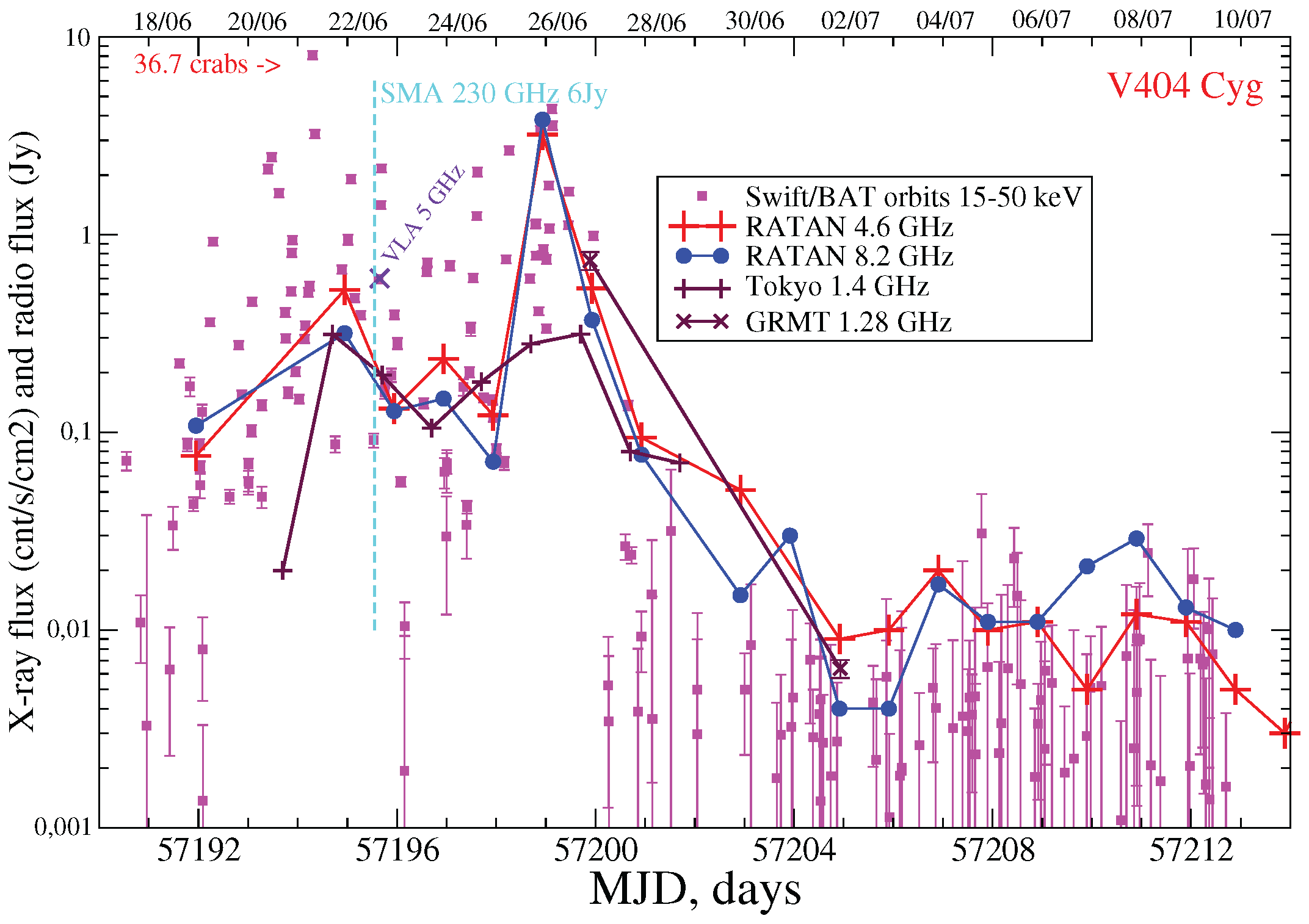
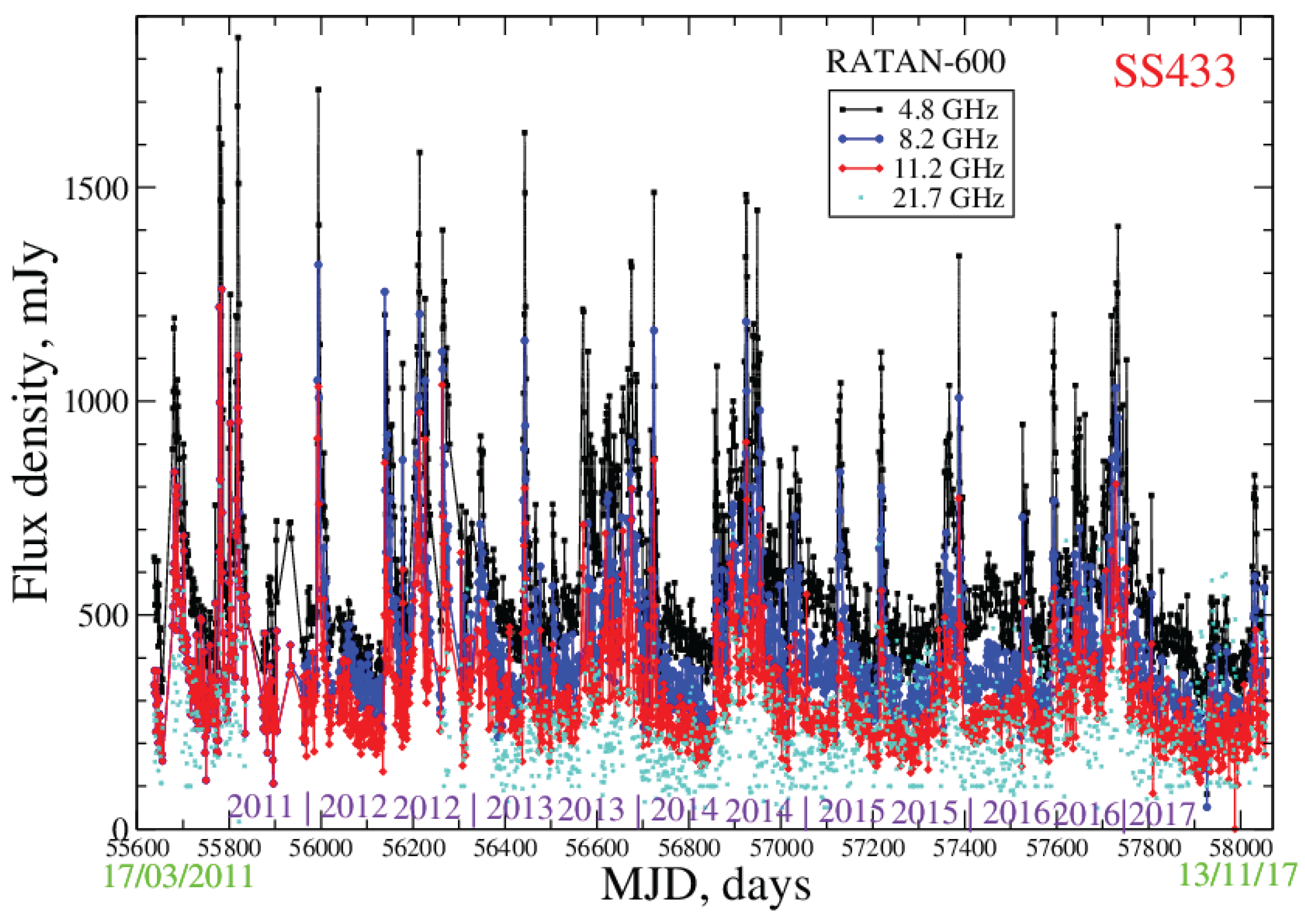
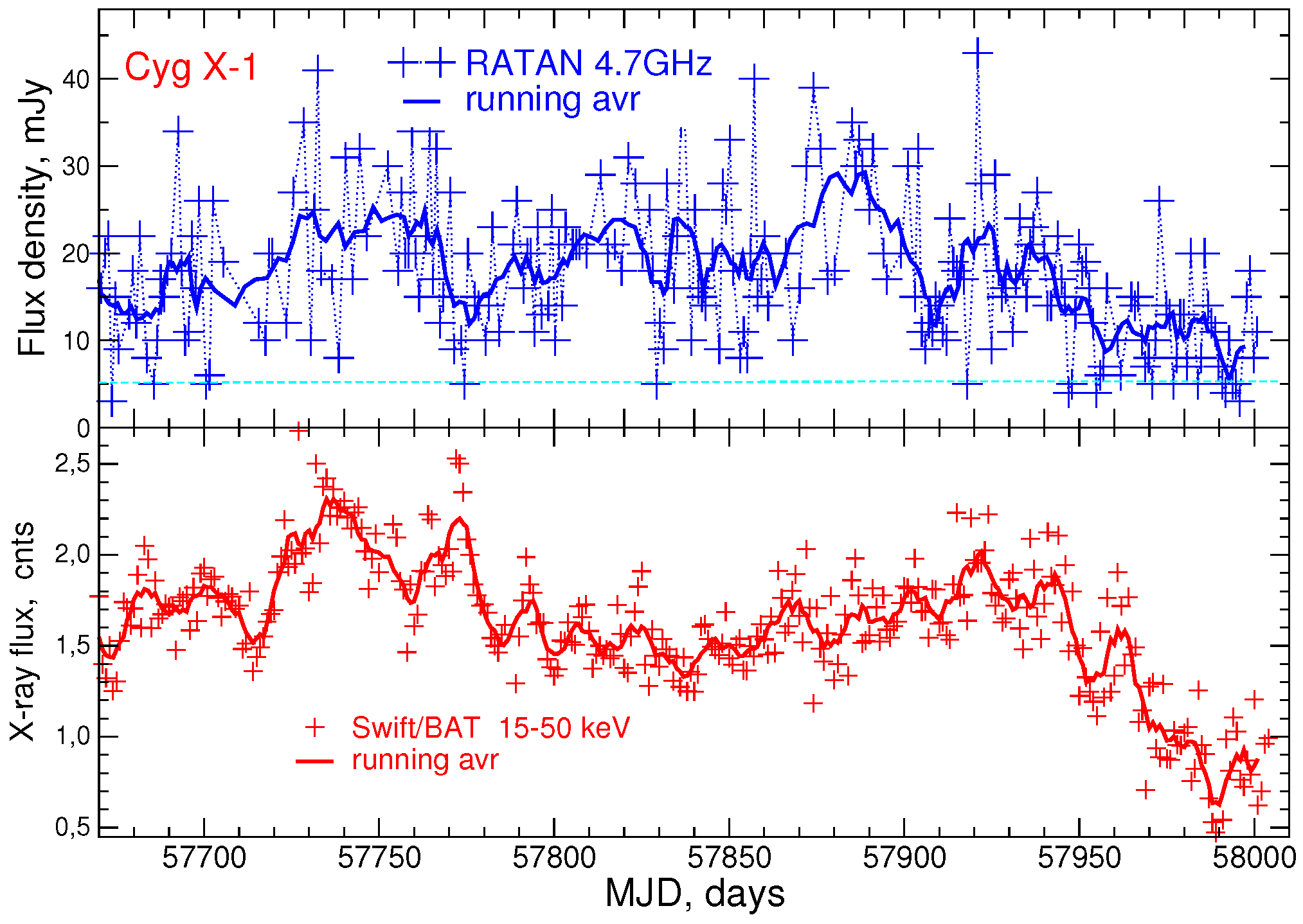

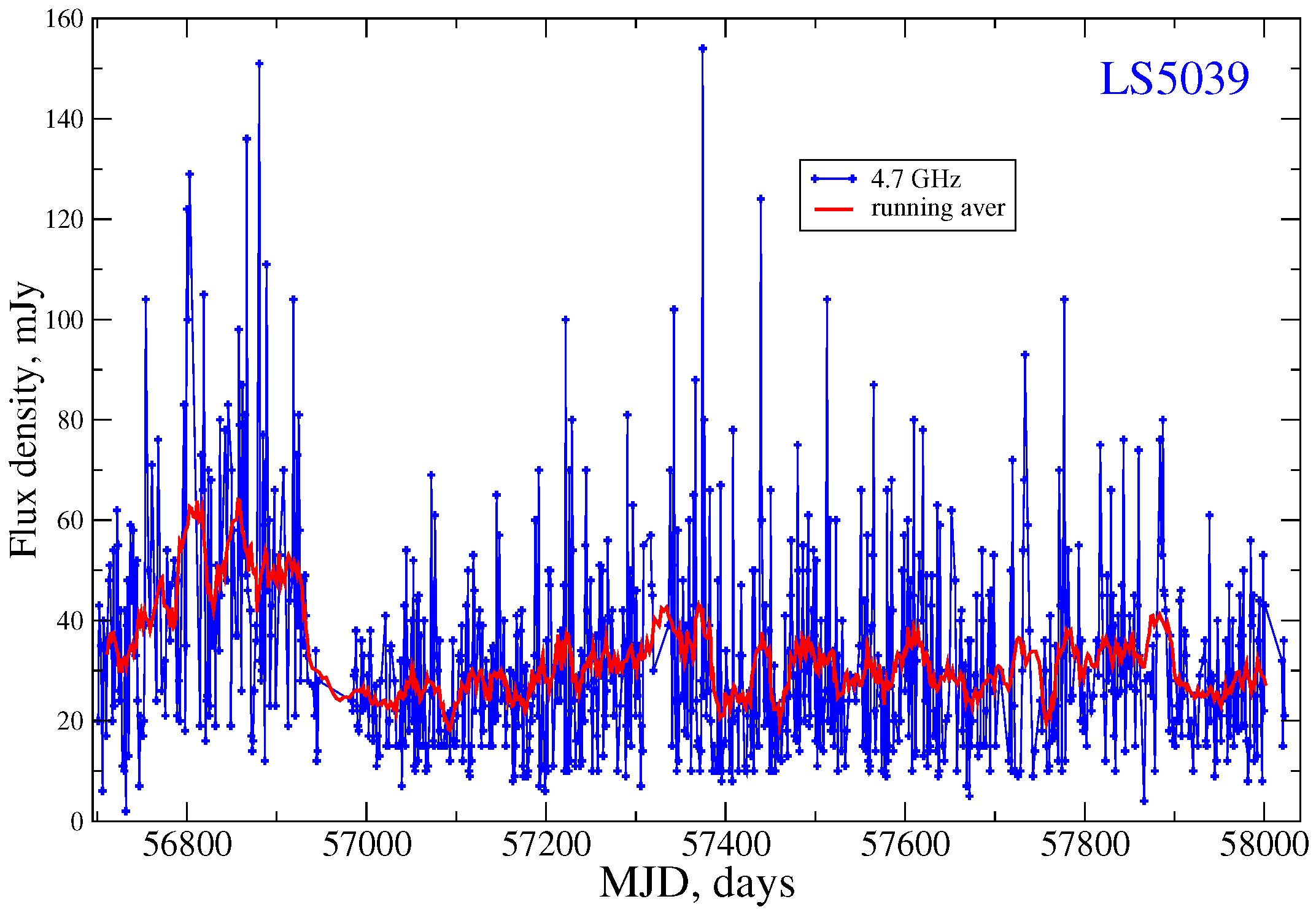
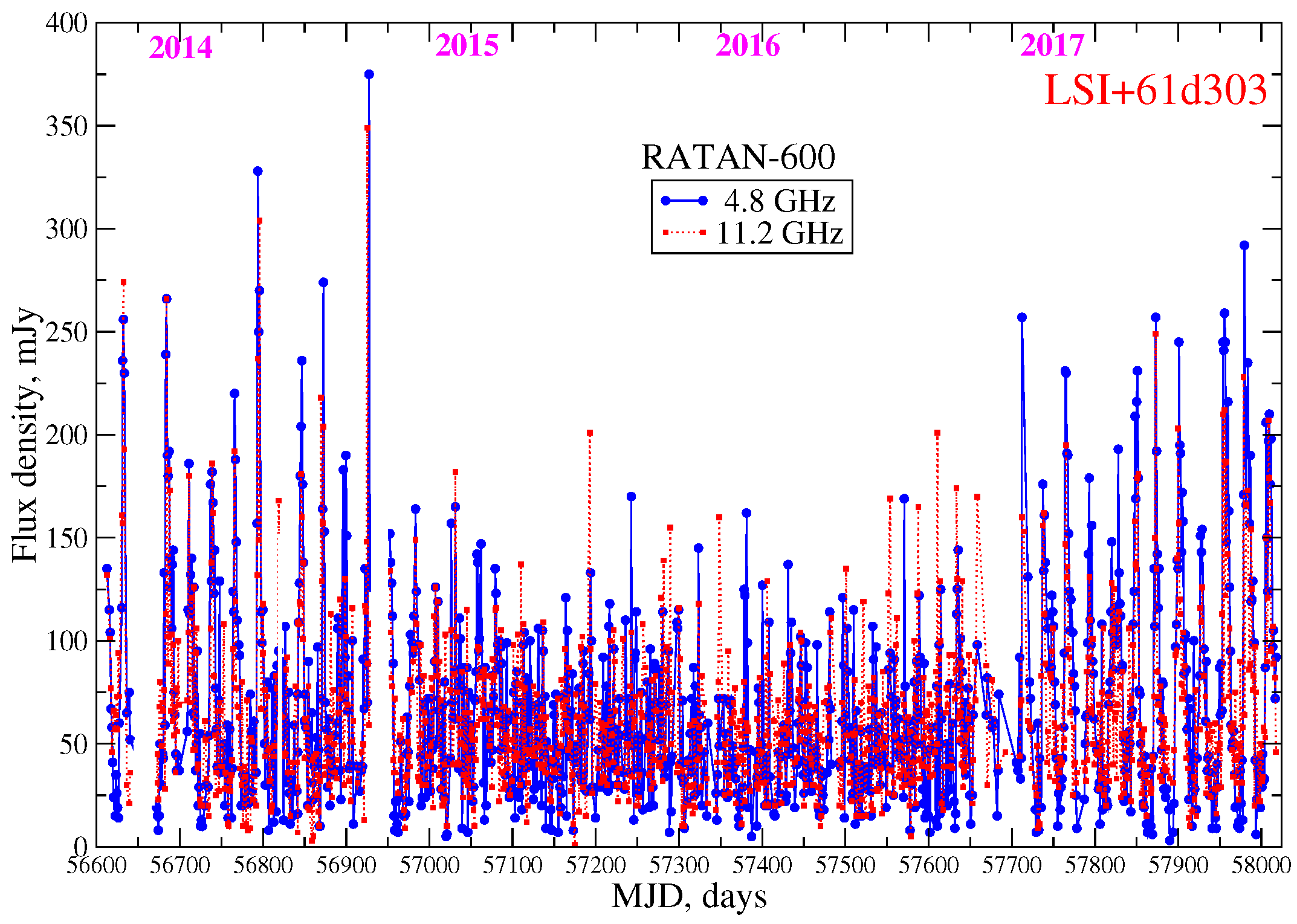
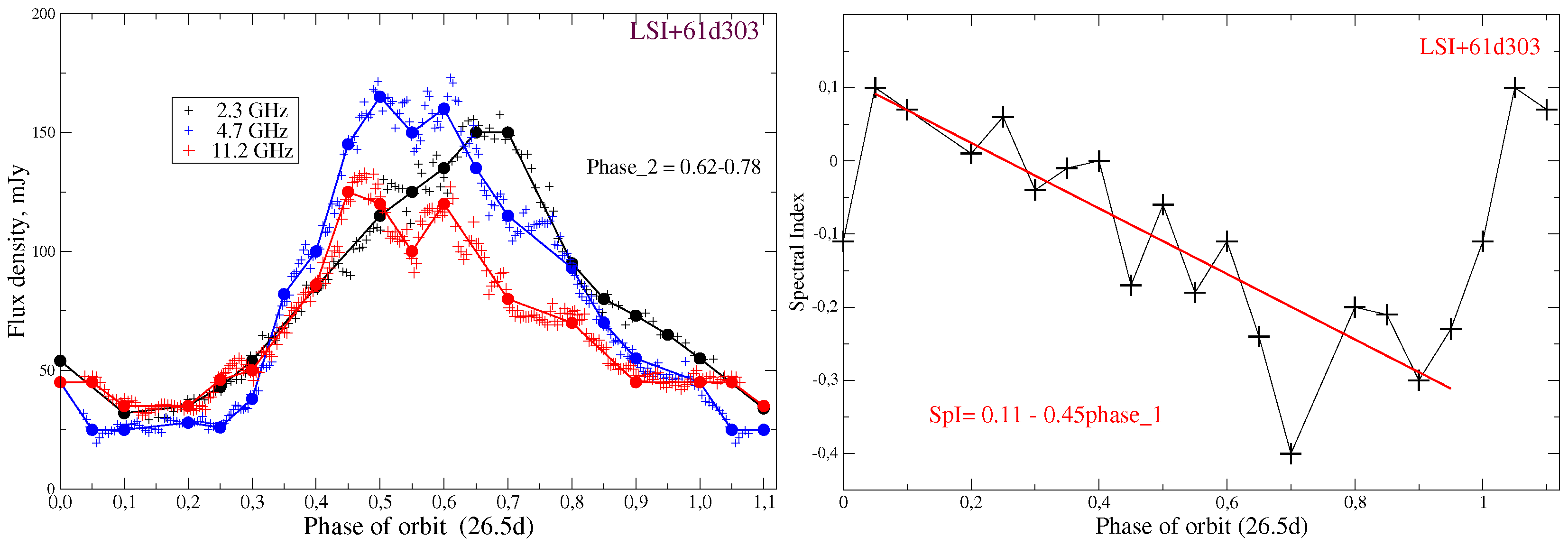
© 2017 by the authors. Licensee MDPI, Basel, Switzerland. This article is an open access article distributed under the terms and conditions of the Creative Commons Attribution (CC BY) license (http://creativecommons.org/licenses/by/4.0/).
Share and Cite
Trushkin, S.; Nizhelskij, N.; Tsybulev, P.; Zhekanis, G. The Jets of Microquasars during Giant Flares and Quiet State. Galaxies 2017, 5, 84. https://doi.org/10.3390/galaxies5040084
Trushkin S, Nizhelskij N, Tsybulev P, Zhekanis G. The Jets of Microquasars during Giant Flares and Quiet State. Galaxies. 2017; 5(4):84. https://doi.org/10.3390/galaxies5040084
Chicago/Turabian StyleTrushkin, Sergei, Nikolaj Nizhelskij, Peter Tsybulev, and Gennadij Zhekanis. 2017. "The Jets of Microquasars during Giant Flares and Quiet State" Galaxies 5, no. 4: 84. https://doi.org/10.3390/galaxies5040084




